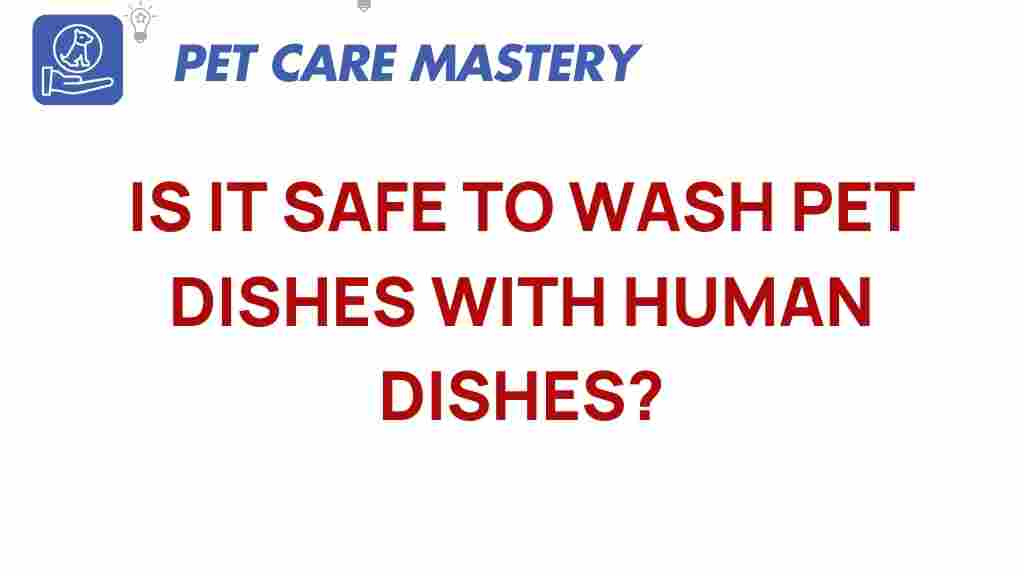Is It Safe to Wash Pet Dishes with Human Dishes? Understanding Pet Hygiene
Maintaining proper pet hygiene is crucial for the health and well-being of your furry friends. One common question among pet owners is whether it’s safe to wash pet dishes with human dishes. This concern stems from the potential for cross-contamination and the spread of bacteria. In this article, we will explore the implications of washing pet dishes with human dishes and provide tips for ensuring optimal hygiene for both pets and humans.
Why Pet Hygiene Matters
Keeping your pet’s dishes clean is integral to maintaining their overall health. Dirty dishes can harbor harmful bacteria, mold, and parasites that may affect your pet’s health. Here are a few reasons why pet hygiene is essential:
- Prevention of Illness: Regularly cleaning your pet’s dishes prevents the growth of harmful microorganisms that can lead to gastrointestinal issues and other health problems.
- Allergy Control: Residue from food can lead to allergic reactions in sensitive pets, making it essential to keep their feeding areas clean.
- Odor Reduction: Dirty dishes can emit unpleasant smells that can linger in your home, affecting the overall air quality.
The Risks of Washing Pet Dishes with Human Dishes
Now, let’s address the core question: Is it safe to wash pet dishes with human dishes? While it may seem convenient, there are several risks you should consider:
- Cross-Contamination: Washing pet dishes with human dishes can lead to the transfer of bacteria from pet food to human dishes. This is especially concerning if your pet has been ill.
- Pesticide Residues: Pet dishes can sometimes contain residues from pet food, which may be treated with pesticides. Mixing these with human dishes can pose health risks.
- Dishwasher Temperature: Not all dishwashers reach the high temperatures necessary to kill harmful bacteria effectively. This can leave both pet and human dishes at risk.
Step-by-Step Process for Properly Cleaning Pet Dishes
To ensure that your pet’s dishes are hygienically cleaned without risking contamination with your human dishes, follow these steps:
1. Gather Your Supplies
Before you start, make sure you have the following supplies:
- Separate dish soap (preferably fragrance-free)
- Hot water
- Scrub brush or sponge
- Dish towels or drying rack
2. Rinse the Dishes
Begin by rinsing the pet dishes in hot water to remove any leftover food particles. This step is crucial in preventing bacteria from multiplying.
3. Apply Dish Soap
Use a separate dish soap to wash the pet dishes. This is important to avoid any potential transfer of chemicals from human dish soap to pet food. Make sure the soap is safe for pets and free from harmful additives.
4. Scrub Thoroughly
Using a scrub brush or sponge, clean the dishes thoroughly. Pay special attention to any grooves or crevices where food particles may hide.
5. Rinse Completely
Rinse the dishes well with hot water to ensure all soap residues are removed. Soap residues can cause digestive issues for pets if ingested.
6. Dry the Dishes
Allow the dishes to air dry on a clean dish towel or drying rack. Make sure they are completely dry before filling them with food or water.
Frequently Asked Questions About Pet Hygiene
Can I Use the Same Sponge for Both Pet and Human Dishes?
It’s best to use separate sponges for pet and human dishes to avoid cross-contamination. Using the same sponge can transfer bacteria from pet dishes to human dishes and vice versa.
How Often Should I Clean My Pet’s Dishes?
Pet dishes should be cleaned daily, especially if they contain wet food, which can attract bacteria. For dry food, a thorough cleaning once a week is usually sufficient.
Is It Necessary to Disinfect Pet Dishes?
While regular cleaning is essential, disinfecting pet dishes every once in a while can help eliminate any stubborn bacteria. Use a pet-safe disinfectant and rinse the dishes thoroughly afterward.
Troubleshooting Tips for Pet Hygiene
Even with the best intentions, maintaining pet hygiene can sometimes be challenging. Here are some troubleshooting tips:
- If You Notice Odors: If pet dishes develop an odor, it may be time to use a stronger cleaning solution or consider using a dishwasher on a hot cycle if the dishes are dishwasher safe.
- For Stubborn Stains: Baking soda mixed with water can be an effective natural cleaner for tough stains on pet dishes. Apply, scrub, and rinse well.
- If Pets Refuse to Eat: If your pet shows a sudden disinterest in food, check their dish for cleanliness. Sometimes pets can be sensitive to residues or odors that we might not notice.
Conclusion: Prioritize Pet Hygiene
In conclusion, while washing pet dishes with human dishes may seem convenient, it poses potential risks that can compromise both pet hygiene and human health. It is best to keep pet dishes separate and clean them regularly with proper techniques. By prioritizing hygiene for your pets, you ensure their well-being and the safety of your household.
For more information on pet care and hygiene practices, you can visit this resource. Always remember, a healthy pet is a happy pet!
If you’re looking for more tips on maintaining a clean home with pets, check out our guide here.
This article is in the category Health and created by PetCareMastery Team
